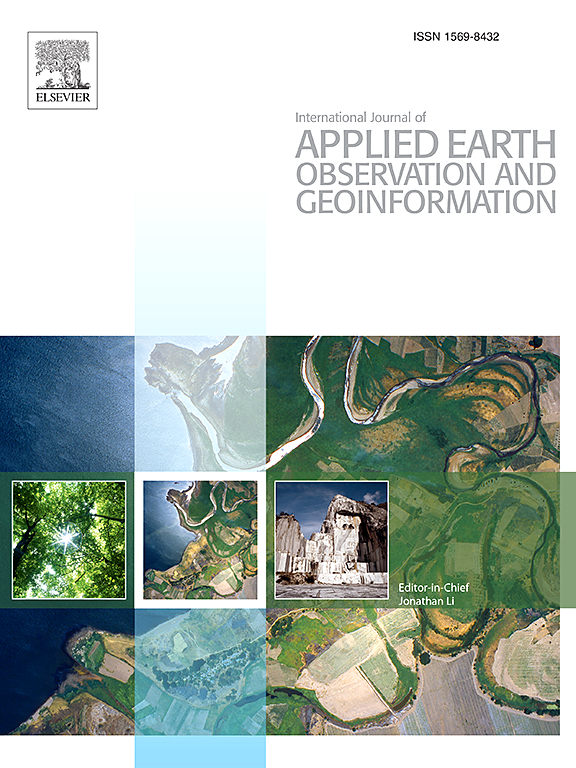RADARSAT constellation mission compact polarisation SAR data for burned area mapping with deep learning
IF 8.6
Q1 REMOTE SENSING
International journal of applied earth observation and geoinformation : ITC journal
Pub Date : 2025-06-09
DOI:10.1016/j.jag.2025.104615
引用次数: 0
Abstract
Monitoring wildfires has become increasingly critical due to the sharp rise in wildfire incidents in recent years. Optical satellites like Sentinel-2 and Landsat are extensively utilised for mapping burned areas. However, the effectiveness of optical sensors is compromised by clouds and smoke, which obstruct the detection of burned areas. Thus, satellites equipped with Synthetic Aperture Radar (SAR), such as dual-polarisation Sentinel-1 and quad-polarisation RADARSAT-1/-2 C-band SAR, which can penetrate clouds and smoke, are investigated for mapping burned areas. However, there is limited research on using compact polarisation (compact-pol) C-band RADARSAT Constellation Mission (RCM) SAR data for this purpose. This study aims to investigate the capacity of compact polarisation RCM data for burned area mapping through deep learning. Compact-pol m- decomposition and Compact-pol Radar Vegetation Index (CpRVI) are derived from the RCM Multi-Look Complex product. A deep-learning-based processing pipeline incorporating ConvNet-based and Transformer-based models is applied for burned area mapping, with three different input settings: using only log-ratio dual-polarisation intensity images, using only compact-pol decomposition plus CpRVI, and using all three data sources. The training dataset comprises 46,295 patches, generated from 12 major wildfire events in Canada. The test dataset includes seven wildfire events from the 2023 and 2024 Canadian wildfire seasons in Alberta, British Columbia, Quebec and the Northwest Territories. The results demonstrate that compact-pol m- decomposition and CpRVI images significantly complement log-ratio images for burned area mapping. The best-performing Transformer-based model, UNETR, trained with log-ratio, m- m-decomposition, and CpRVI data, achieved an F1 Score of 0.718 and an IoU Score of 0.565, showing a notable improvement compared to the same model trained using only log-ratio images (F1 Score: 0.684, IoU Score: 0.557). This is the first study to demonstrate that RCM C-band SAR data and its derived features are effective for burned area mapping.
RADARSAT星座任务压缩极化SAR数据,用于深度学习的烧伤区域测绘
由于近年来野火事件的急剧增加,监测野火变得越来越重要。像Sentinel-2和Landsat这样的光学卫星被广泛用于绘制烧毁地区的地图。然而,光学传感器的有效性受到云层和烟雾的影响,这阻碍了对烧伤区域的探测。因此,配备合成孔径雷达(SAR)的卫星,如双偏振Sentinel-1和四偏振RADARSAT-1/ 2 c波段SAR,可以穿透云层和烟雾,用于测绘烧伤区域。然而,使用紧凑偏振(compact-pol) c波段雷达卫星星座任务(RCM) SAR数据用于这一目的的研究有限。本研究旨在通过深度学习研究紧凑极化RCM数据在烧伤区域测绘中的能力。Compact-pol m-χ分解和Compact-pol雷达植被指数(Compact-pol Radar Vegetation Index, CpRVI)是由RCM Multi-Look Complex产品导出的。基于深度学习的处理管道结合了基于convnet和基于transformer的模型,应用于烧伤区域映射,有三种不同的输入设置:仅使用对数比双偏振强度图像,仅使用紧凑pol分解和CpRVI,以及使用所有三种数据源。训练数据集包括46,295个补丁,来自加拿大的12个主要野火事件。测试数据集包括艾伯塔省、不列颠哥伦比亚省、魁北克省和西北地区2023年和2024年加拿大野火季节的七次野火事件。结果表明,compact-pol m-χ分解和CpRVI图像可以有效地补充对数比图像。使用对数比、m-χ m分解和CpRVI数据训练的基于变压器的最佳模型UNETR的F1得分为0.718,IoU得分为0.565,与仅使用对数比图像训练的相同模型(F1得分:0.684,IoU得分:0.557)相比,有显著改善。这是首次证明RCM c波段SAR数据及其衍生特征对烧伤区域测绘有效的研究。
本文章由计算机程序翻译,如有差异,请以英文原文为准。
求助全文
约1分钟内获得全文
求助全文
来源期刊

International journal of applied earth observation and geoinformation : ITC journal
Global and Planetary Change, Management, Monitoring, Policy and Law, Earth-Surface Processes, Computers in Earth Sciences
CiteScore
12.00
自引率
0.00%
发文量
0
审稿时长
77 days
期刊介绍:
The International Journal of Applied Earth Observation and Geoinformation publishes original papers that utilize earth observation data for natural resource and environmental inventory and management. These data primarily originate from remote sensing platforms, including satellites and aircraft, supplemented by surface and subsurface measurements. Addressing natural resources such as forests, agricultural land, soils, and water, as well as environmental concerns like biodiversity, land degradation, and hazards, the journal explores conceptual and data-driven approaches. It covers geoinformation themes like capturing, databasing, visualization, interpretation, data quality, and spatial uncertainty.
 求助内容:
求助内容: 应助结果提醒方式:
应助结果提醒方式:


